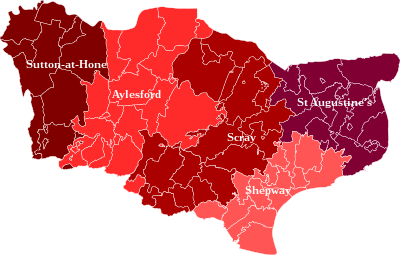Lathe of Sutton-at-Hone: Difference between revisions
Created page with "{{county|Kent}} The '''Lathe of Sutton-at-Hone''' is one of the five Lathes of Kent, encompassing much of the western parts of Kent, including those area swallowed wit..." |
No edit summary |
||
| (One intermediate revision by the same user not shown) | |||
| Line 1: | Line 1: | ||
{{county|Kent}} | {{county|Kent}} | ||
The '''Lathe of Sutton-at-Hone''' is one of the five [[Lathes of Kent]], encompassing much of the western parts of [[Kent]], including those area swallowed | [[File:Lathes and hundreds of Kent.svg|thumb|400px|Lathes and hundreds of Kent]] | ||
The '''Lathe of Sutton-at-Hone''' is one of the five [[Lathes of Kent]], encompassing much of the western parts of [[Kent]], including those area swallowed within the metropolitan conurbation. It is named after the village and parish of [[Sutton at Hone]] in the [[River Darent|Darent valley]]. | |||
The village of Sutton at Hone is about two miles from Dartford, one of only four royal manors in Kent at the time of the [[Domesday Book]].<ref>Dartford Country - The Story Of The Hundred Of Axstane by G. Porteus (page 22)</ref> At that time, Sutton was ranked as a "Half Lathe", as was [[Milton Regis|Milton]], to which it was not connected. Alongside these two Half Lathes were five (full) Lathes: [[Lathe of Aylesford|Aylesford]], Borough, [[Eastry]], Lympne (later renamed [[Lathe of Shepway|Shepway]]) and [[Wye, Kent|Wye]]. By 1295 Sutton had been promoted to a full lathe, while alongside it were only four other lathes, as Borough and Eastry had merged into the [[Lathe of St Augustine]], while Milton and Wye had merged to form the [[Lathe of Scray]].<ref>The Hidation of Kent by J. E. A. Jolliffe, in The English Historical Review Vol. 44, No. 176 (Oct., 1929, OUP), pp. 612-618. See http://www.jstor.org/stable/552921/10.2307/552921</ref> | The village of Sutton at Hone is about two miles from Dartford, one of only four royal manors in Kent at the time of the [[Domesday Book]].<ref>Dartford Country - The Story Of The Hundred Of Axstane by G. Porteus (page 22)</ref> At that time, Sutton was ranked as a "Half Lathe", as was [[Milton Regis|Milton]], to which it was not connected. Alongside these two Half Lathes were five (full) Lathes: [[Lathe of Aylesford|Aylesford]], Borough, [[Eastry]], Lympne (later renamed [[Lathe of Shepway|Shepway]]) and [[Wye, Kent|Wye]]. By 1295 Sutton had been promoted to a full lathe, while alongside it were only four other lathes, as Borough and Eastry had merged into the [[Lathe of St Augustine]], while Milton and Wye had merged to form the [[Lathe of Scray]].<ref>The Hidation of Kent by J. E. A. Jolliffe, in The English Historical Review Vol. 44, No. 176 (Oct., 1929, OUP), pp. 612-618. See http://www.jstor.org/stable/552921/10.2307/552921</ref> | ||
The Lathe of Sutton is the most populous lathe in Kent, because of the dense | The Lathe of Sutton is the most populous lathe in Kent, because of the dense urban development in the county's north-western corner. At over 1.3 million inhabitants it contains nearly half the county's total population. | ||
It contains the following hundreds: | |||
*[[Blackheath Hundred, Kent|Blackheath]] | *[[Blackheath Hundred, Kent|Blackheath]] | ||
| Line 16: | Line 19: | ||
*[[Somerden Hundred|Somerden]] | *[[Somerden Hundred|Somerden]] | ||
The first four hundreds comprising the metropolitan parts of the Lathe. | |||
The Lathe of Sutton has an area of 173,440 acres (271 sq. miles | The Lathe of Sutton has an area of 173,440 acres (271 sq. miles).<ref>The Hidation of Kent by J. E. A. Jolliffe and Census 1832</ref> | ||
==References== | ==References== | ||
{{reflist}} | {{reflist}} | ||
{{Kent hundreds}} | |||
[[Category:Lathes of Kent|Sutton]] | [[Category:Lathes of Kent|Sutton]] | ||
Latest revision as of 11:31, 4 November 2019

The Lathe of Sutton-at-Hone is one of the five Lathes of Kent, encompassing much of the western parts of Kent, including those area swallowed within the metropolitan conurbation. It is named after the village and parish of Sutton at Hone in the Darent valley.
The village of Sutton at Hone is about two miles from Dartford, one of only four royal manors in Kent at the time of the Domesday Book.[1] At that time, Sutton was ranked as a "Half Lathe", as was Milton, to which it was not connected. Alongside these two Half Lathes were five (full) Lathes: Aylesford, Borough, Eastry, Lympne (later renamed Shepway) and Wye. By 1295 Sutton had been promoted to a full lathe, while alongside it were only four other lathes, as Borough and Eastry had merged into the Lathe of St Augustine, while Milton and Wye had merged to form the Lathe of Scray.[2]
The Lathe of Sutton is the most populous lathe in Kent, because of the dense urban development in the county's north-western corner. At over 1.3 million inhabitants it contains nearly half the county's total population.
It contains the following hundreds:
- Blackheath
- Bromley and Beckenham
- Ruxley
- Little and Lesnes
- Dartford and Wilmington
- Axstane
- Codsheath
- Westerham and Edenbridge
- Somerden
The first four hundreds comprising the metropolitan parts of the Lathe.
The Lathe of Sutton has an area of 173,440 acres (271 sq. miles).[3]
References
- ↑ Dartford Country - The Story Of The Hundred Of Axstane by G. Porteus (page 22)
- ↑ The Hidation of Kent by J. E. A. Jolliffe, in The English Historical Review Vol. 44, No. 176 (Oct., 1929, OUP), pp. 612-618. See http://www.jstor.org/stable/552921/10.2307/552921
- ↑ The Hidation of Kent by J. E. A. Jolliffe and Census 1832